The Best Indonesian Noodles (Mee Goreng)
on Nov 19, 2020, Updated Apr 29, 2023
This post may contain affiliate links. Please read my disclosure for more info.
This honestly is the best recipe ever for Indonesian noodles, otherwise known as mee goreng. A street food favorite in Indonesia, Malaysia and other parts of South East Asia, they’re so easy to make at home. Mildly spicy, packed with sweet, sticky, delicious flavours and ready in just 30 minutes.
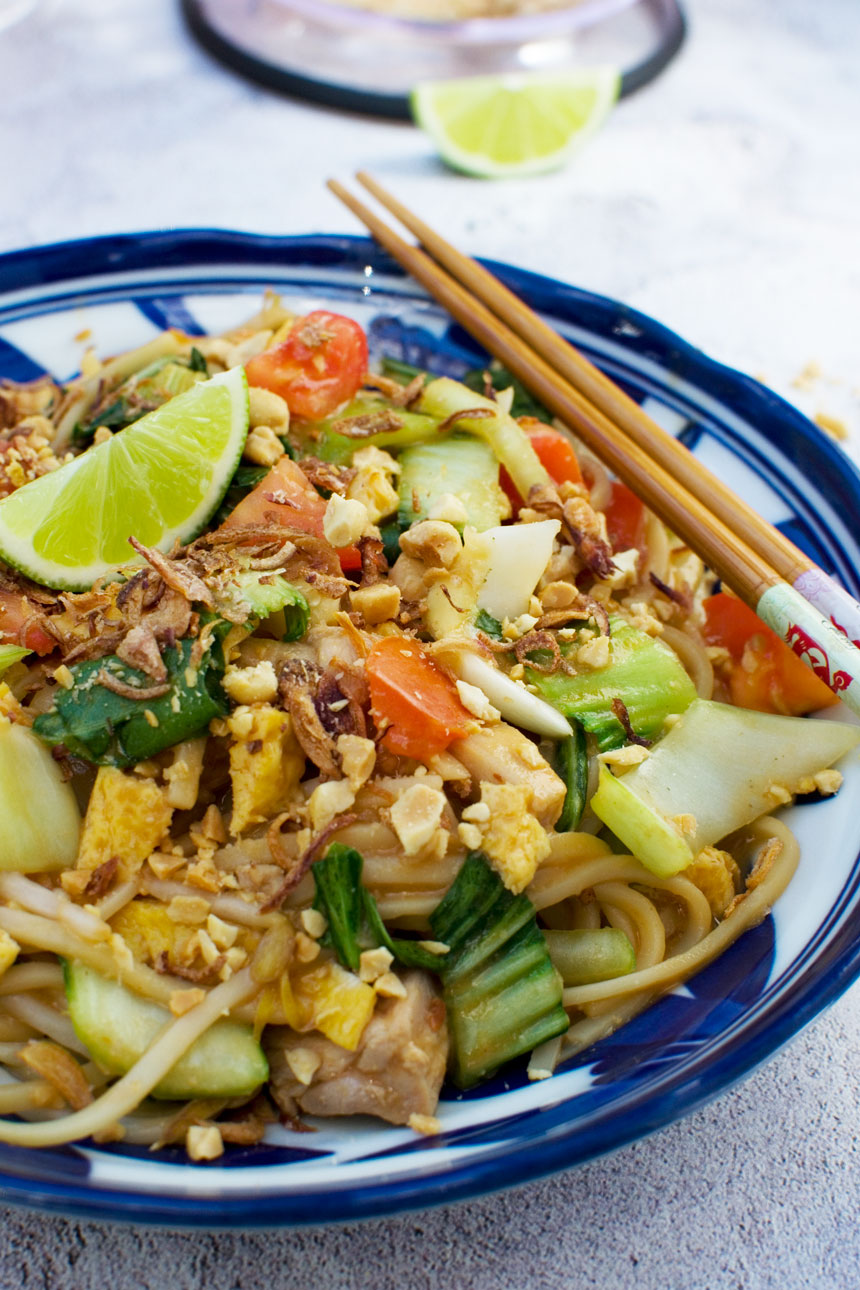
When I visited Singapore, Mr. Scrummy and I ate virtually every meal in the incredible street food markets there. One of the dishes we both enjoyed the most was mee goreng, an amazingly tasty fried egg noodles dish.
From the moment we got home, I was on a quest to make the best version of this new favourite dish I’d discovered. I hope you give it a try and enjoy it as much as we still do.
What is mee goreng?
I first discovered this dish in Indonesia, but it’s popular in Malaysia and other parts of Asia, too.
Essentially mee goreng (sometimes called mi goreng or mie goreng) is a mildy spicy chicken noodle stir fry with egg and Asian greens and beensprouts and other yummy things.
One of the things I love about it is that there is a range of textures. So in mee goreng you’ll find:
- fresh and crunchy Asian vegetables
- yummy fried egg noodles
- tasty chunks of tender chicken
- a tangy, mildly spicy sauce (plenty of it in my version!)
- a crispy, crunchy garnish of peanuts, crispy dried onions (my favourite!) and lime segments.
Just slice down the middle of Asian greens like the baby pak choi shown here length-ways, then chop like you would a leek. Then wash really well! It can be gritty!
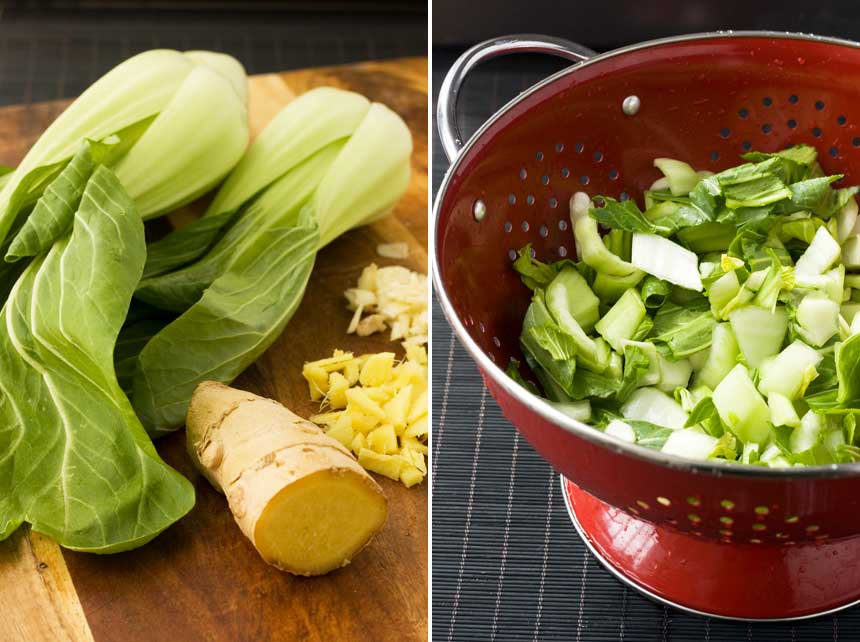
Why I think this is the best recipe
I don’t claim my mee goreng recipe to be perfectly authentic. Over time I’ve developed it to include all the best things from the different versions of the recipe I’ve seen.
This is one of those dishes that everyone has their own version of. Some recipes include eggs, for instance, so I do too. There are chopped tomatoes in my version, too, for extra juice and taste.
The dish ends up neither too spicy nor too bland. Full of ‘bits’ but with plenty of the comforting noodles, too.
But what really takes these Indonesian street noodles from good to delicious? Easy – the sauce and the toppings!
The sauce
I used to be afraid of long lists of ingredients in Asian stir fry recipes. I still am – a bit – but luckily the sauce in this recipe only contains 6 ingredients + water.
The sauce contains a sticky, sweet version of soy sauce called kecap manis. Don’t worry, it’s easy to find in major supermarkets. I also include… wait for it… tomato ketchup in my version of the sauce!
There’s also light soy sauce, a bit of chili sauce – not too much, and oyster sauce.
Lastly, I add a sneaky tablespoon of peanut butter. Just because.
You could say this version is actually a mee goreng basah, which roughly (very roughly!) translates as very saucy, I make sure there’s just the right amount of sauce!
The toppings
Oh, the toppings. They are not optional. They really aren’t 😉 They are just as important as all the other ingredients to get that perfect flavour explosion in your mouth.
This is what I recommend:
- crushed peanuts
- dried onions, which you can usually grab in the supermarket (if not, it’s well worth hunting them down in an Asian shop!)
- lime segments to squeeze all over just before eating
Oh, and I suggest adding more of the toppings as you eat. Just trust me on that!
How to make it
Like with any stir fry, I find it’s best to get all the ingredients washed, chopped and otherwise prepared before starting to cook. You can even do some of the prep ahead so that it’s a super fast meal when dinnertime comes around.
The prep will take a little while – 15 to 20 minutes. But then it’s just a case of throwing everything together in a wok or other big pan.
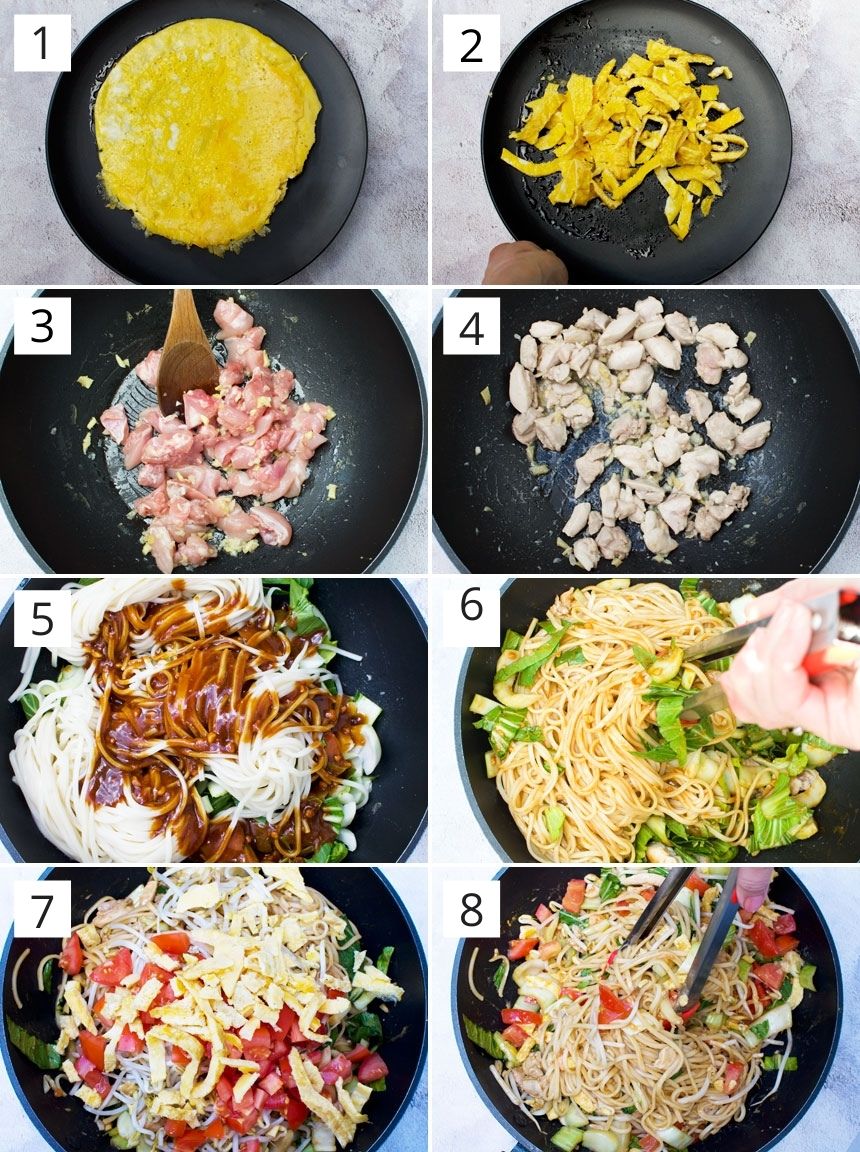
There are really only 5 main steps to the recipe:
Step 1: Cook the egg. Cook it like a big flat omelette. Then roll it up, chop it up, and put it aside. Easy.
Step 2: Cook the chicken with yummy garlic and ginger. At the same time, you can be cooking your egg noodles, which only takes a few minutes.
Step 3: Throw in the greens, noodles, and the sauce.
Step 4: Add the rest of the ingredients – so chopped tomatoes and egg, and the beansprouts. Add a drizzle more water to keep it nice and ‘saucy’.
Step 5: After serving into bowls, sprinkle with the delicious toppings. Grab your chopsticks and eat!
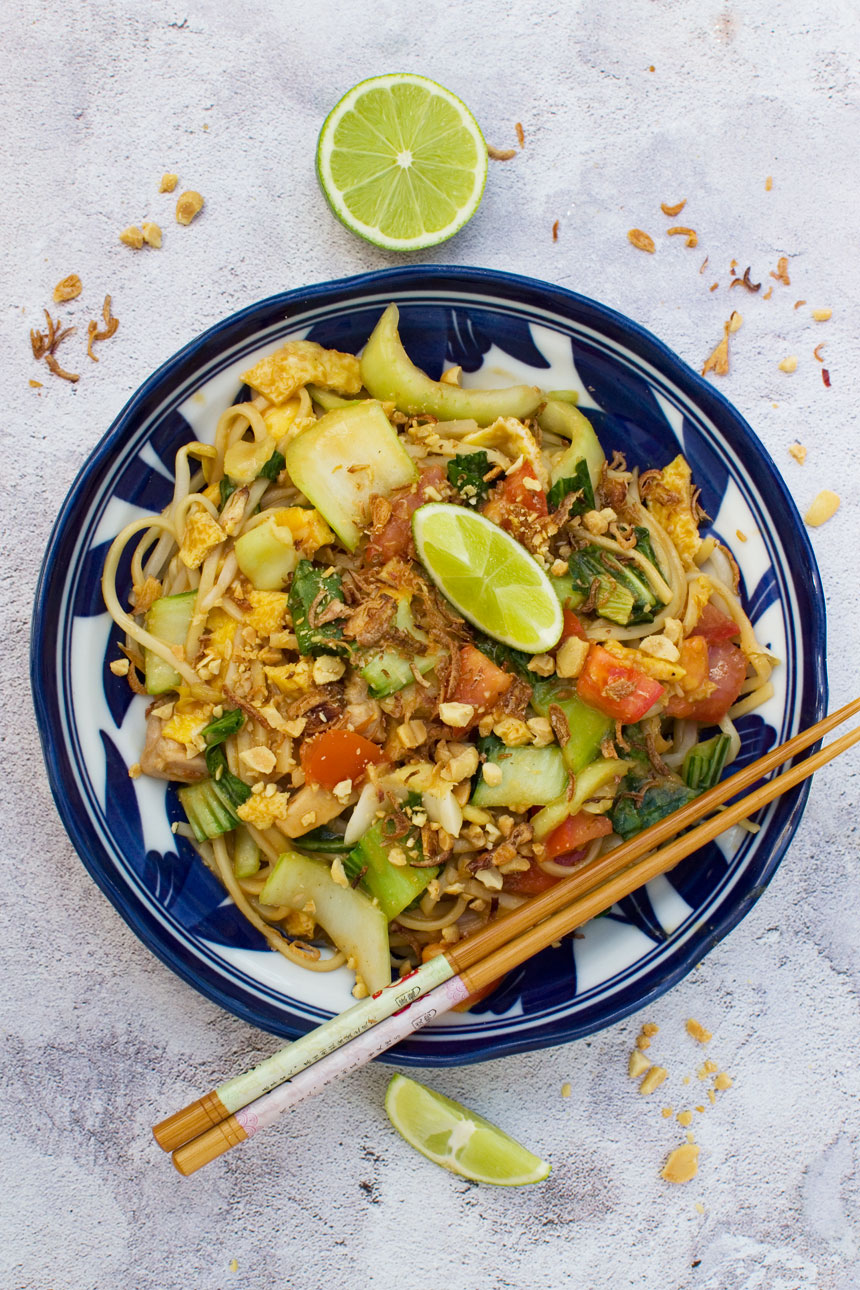
What kind of noodles to use
This dish is made with egg noodles. I usually use medium sized egg noodles – so neither super thick nor super skinny.
But really it’s up to you. You can even use a different type of noodle like wheat or rice noodles if that’s what you have.
Sometimes I buy fresh noodles, called Hokkien noodles in the supermarket I go to. Other times I buy dried egg noodles. Again, it really doesn’t matter.
The only important thing is to use less than half the weight of fresh noodles if you’re using dried. For example: Use 400 grams or 14 ounces of fresh noodles but only 170 grams or 6 ounces of dried noodles.
Make the recipe your own
I’ve already told you that I took a while to refine this recipe to make it my own.
Mine’s an egg noodle stir fry with chicken, but you could make yours a shrimp, pork or beef mee goreng. Or you could skip the meat and add tofu or more vegetables if you prefer.
My stir fry is just mildly spicy, so add more chili sauce if you like to feel the heat. If you like, you could also add an egg on top of your noodles before serving. Yum. The world’s your noodle!
More things to know (recipe FAQ)
Yes. If you prefer to use dried noodles, use just under half the amount of fresh. So you’ll need around 6 ounces or 170 grams of dried noodles for this recipe.
I usually make this dish with chicken, but there’s no reason why you can’t use pork, beef strips, shrimp/prawn, tofu or just loads of vegetables instead. The method won’t really change because the dish is cooked so quickly. Just cook any protein you like at the same time as you would cook the chicken.
I always use chili sauce in my mee goreng recipe. I use around 3 teaspoons so that the noodles are just mildly spicy. Honestly though, tweak the amount to your heart’s content! It can be as spicy (or not) as you like.
I usually grab a bottle of sriracha sauce from the Asian aisle at my local supermarket. But really any kind of chili sauce works. You can even use sambal oelek as a substitute, or you can skip the chili sauce altogether and just add more ketchup if you’re not a fan of spicy dishes at all.
Gosh yes. Like any good takeout style dish, the leftovers reheat really well. Simply cover and reheat for 3 to 4 minutes on 80% power in your microwave. Sometimes I add a little drizzle of water before reheating so that the dish is nice and ‘saucy’ again.
Alternatively you can reheat the leftovers in a wok. Just add a drizzle more water and stir fry again for a few minutes until piping hot.
Add some fresh toppings (peanuts, lime, crispy shallots, coriander) after heating for a meal that’s as good as new. Yum.
Ha! Great question! I always used to wonder that too.
Basically, ‘mee goreng’ means fried noodles in Indonesian. ‘Nasi goreng’ means fried rice. So they are similar stir-fried dishes with sweet soy sauce, vegetables and protein but one is made with noodles and the other with rice!
Here is a recipe for nasi goreng from Nagi at Recipe Tin Eats if you’d like to try that too.
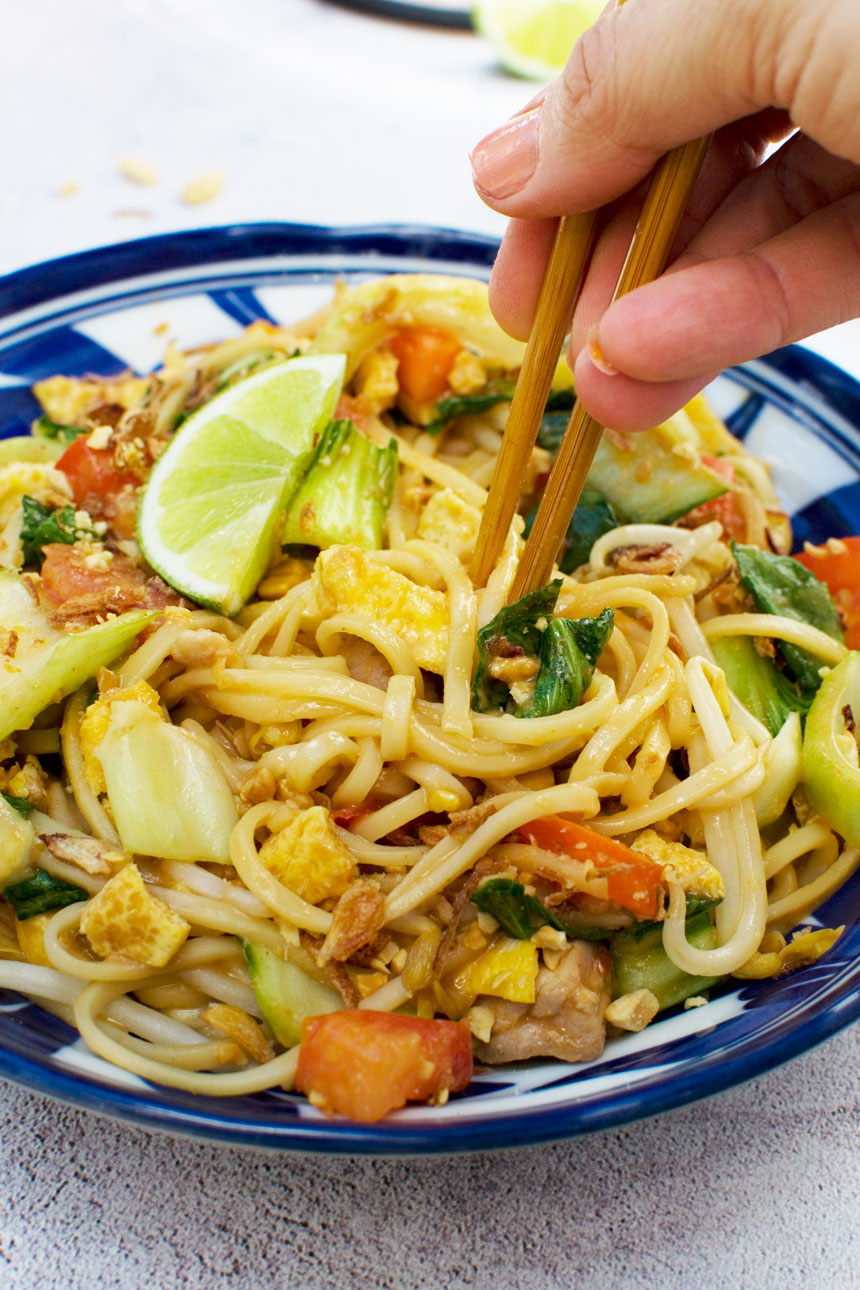
More easy Asian meals
- 15 minute Thai basil pork stir fry (delicious!)
- This 20-minute chicken and cashew nuts is another quick and easy Chinese takeout classic!
- Perfect Thai chicken and butternut squash curry (On the table in 40 minutes and makes a TON. We ALWAYS have some of this in our freezer!). More in the mood for fish? Try this 20-minute Thai green curry with fish.
- Sticky and delicious 15 minute Shanghai chicken
- This easy chicken katsu curry is one for crispy chicken lovers everywhere, and there’s even an air fryer option!
- Or take a look at all my Asian recipes.
Mee goreng makes a great simple weekend dinner! If you need more ideas, check out this list of 100 easy Sunday dinner ideas.
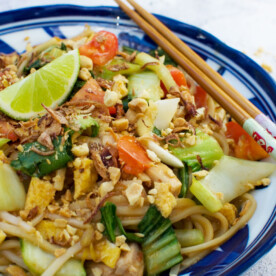
The Best Indonesian Noodles (Mee Goreng)
Equipment
Ingredients
for the sauce
- 1 tablespoon peanut butter
- 1 tablespoon kecap manis, (thick sweet soy sauce)
- 1 tablespoon light soy sauce
- 3 teaspoons chili sauce, I used sriracha, but any is fine
- 1 tablespoon tomato ketchup
- 2 tablespoons oyster sauce
- 3 tablespoons water
for the noodles
- 1 tablespoon vegetable oil, for cooking (or sesame oil)
- 2 eggs, lightly whisked
- 2 garlic cloves, chopped finely or crushed
- 3cm piece fresh ginger, (about a thumb's width) peeled and chopped finely
- 7 ounces chicken breast, or 2 chicken thighs, chopped into smallish chunks
- 9 ounces baby pak choi, chopped and washed
- 14 ounces fresh egg noodles, or 6 ounces/170 grams dried
- 3.5 ounces beansprouts, I use fresh but canned would be OK too. (3.5 ounces is 100 grams or 2 large handfuls)
- 2 medium tomatoes, roughly diced
toppings
- lime segments
- crispy fried shallots
- crushed peanuts or cashew nuts
Instructions
- In a medium bowl or jug, blend the kecap manis (thick sweet soy sauce) and light soy sauce into the peanut butter, then whisk in all the other sauce ingredients. Set aside.
- Add a drizzle of oil to a wok on a medium heat. Then pour eggs in. Roll the pan to spread it out, like you would a pancake. Cook for about a minute. Flip over for a few seconds, then transfer to a plate, roll up and cut into thin strips. Set aside on a plate.
- Add another drizzle of oil to the heated wok/pan, then add the garlic, ginger and chicken. Stir fry until just cooked through (2 to 3 minutes).
- Add the pak choi to the pan and stir fry for another couple of minutes until wilted. Then add the noodles. Pour in the sauce at this point and combine all the ingredients well.
- At the last minute, add the beansprouts, tomatoes and eggs and combine well once again. Add a little extra drizzle of water if you think the dish needs it.
- Serve the noodles immediately, topping with the lime, crispy shallots and crushed nuts. Enjoy!
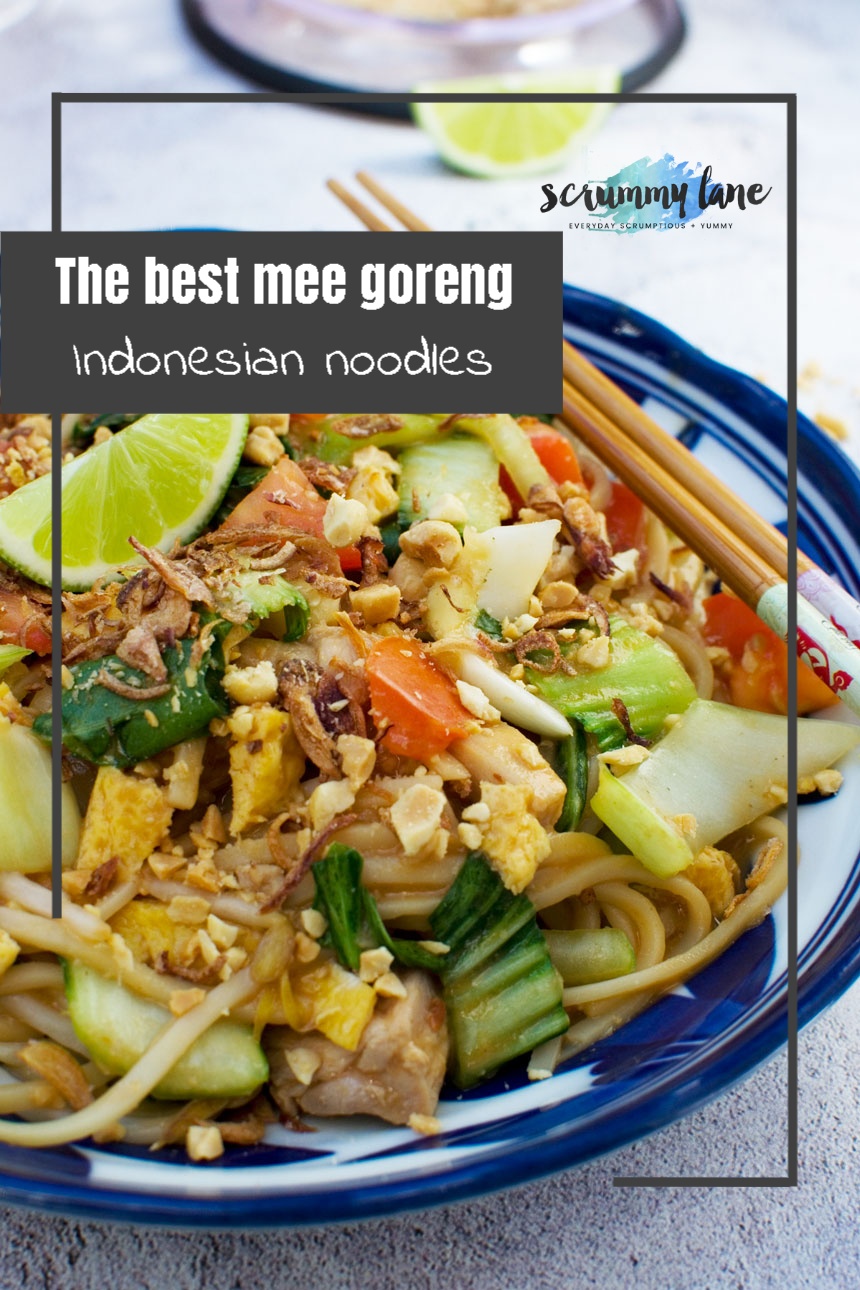
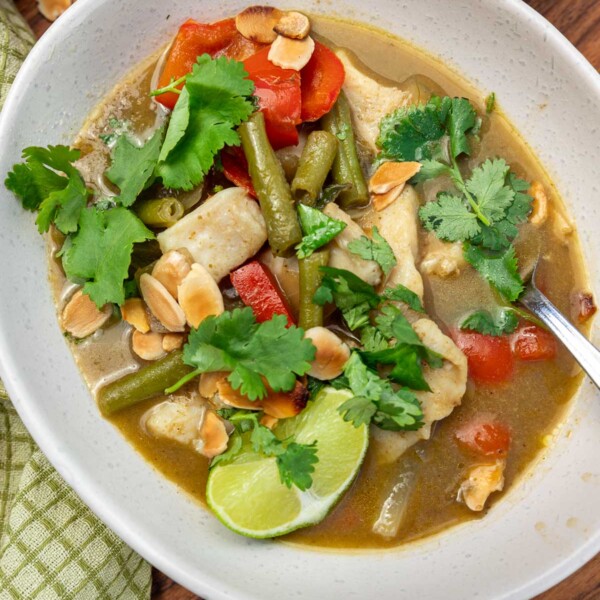
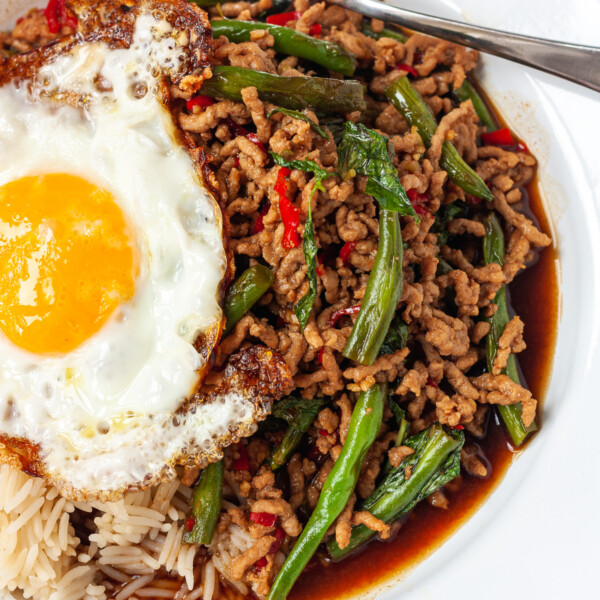
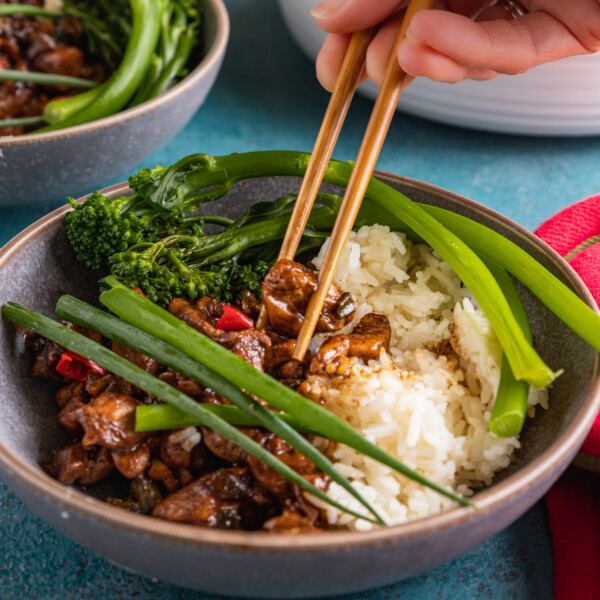
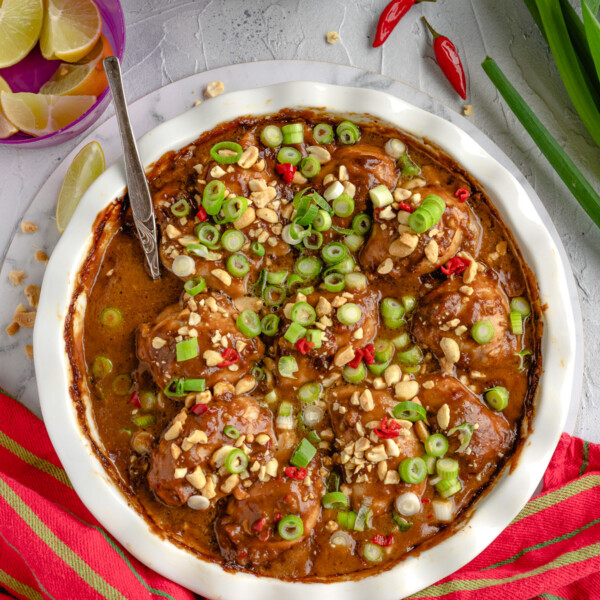






I love noodle dishes! These look divine and packed full of delicious flavours! Lovely recipe, thanks for sharing Helen! 😀
Thank you, Jess! Glad you like them! 🙂
Oh how fantastic!! This looks lovely! I always love a good big bowl of noodles!
Thank you, Annie!
I always order a noodle dish when I eat Asian food. This looks so good and looks so much better, I have to try this for myself.
Really hope you do give it go, Janette! I don’t think you’ll be disappointed if you’re a noodle fan!
This is one of my favourite spicydishes. I love how much flavour it has in it.
It’s really flavourful, isn’t it?? Glad you like it, Dannii 🙂
Wow! This looks heavenly! Sounds like you guys had a great time exploring… and eating 🙂 I could totally go for a big bowl of this right now!
Thanks, Kathleen! 🙂
Helen – This looks so yummy! I don’t think I’ve ever had Indonesian food so I’ll definitely be trying this! Pinned!
Thank you so much for pinning this, Erin. I’m really happy to have introduced you to something new!
We love this dish and always order it when we go to Bali or an Indonesian restaurant. I’ve never made it myself though!
You should give it a go, Lorraine! 🙂
You crack me up, “the ever scrumptious Mr. Scrummy”. 🙂 And these noodles look DELISH!!
Teehee … I better not let him read that. He’ll get a reeelly big head! Very happy you like the noodles!
I have doubt this is delicious. After cooking Sri Lanka with its encyclopedia of ingredients, I realized that’s sometimes what makes these dishes outstanding!
Thank you for your confidence, Chrissy! 🙂
I think I could probably just make this sauce, especially with the addition of the peanut butter and my husband would happily drink it for dinner! But….It think the noodles need to made too. Loving how you used sesame oil (I’m new to the sesame oil scene) and I love the pak choi and bean sprouts as well. I’m learning all sorts of things about ethnic foods and it’s certainly so fun to experiment!
Aw, really happy you like the ethnic spin in today’s post, Laura! This was actually the first time I’d used pak choi, and I loved it! The sesame oil isn’t essential, I suppose, but it really adds a lovely rich extra nuttiness to the dish. Really hope you give this a go some time!